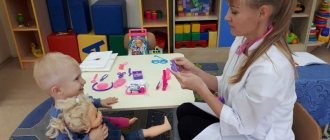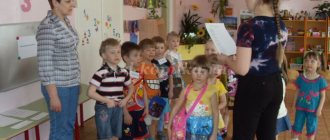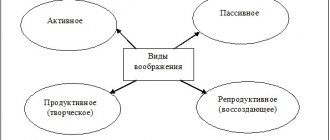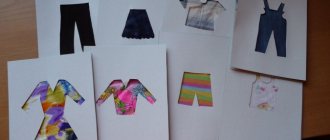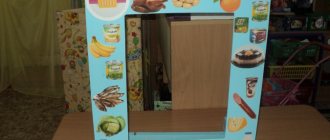Visual and didactic aid. Role-playing speech therapy game “Supermarket”
Visual and didactic aid. Role-playing speech therapy game “Supermarket”
A speech therapist can work without an office, but never without visual aids. I remember these words from my supervisor throughout more than 20 years of my practice. Over the years, I had to work in completely unsuitable conditions, right down to a bench in the school hallway. But the absence of conditions does not relieve me of responsibility for the quality of correctional assistance provided to the child.
By practicing the skill of pronouncing phrases in children, we often achieve significant success in the formation of so-called “desk speech”. Having taken a step beyond it, the child immediately returns to his usual pronunciation. Therefore, in practice, it is important to create and use game situations as often as possible in which children independently construct a phrase and pronounce it, rather than mindlessly memorize ready-made sentences and simple sayings.
Today I want to present to the jury another visual aid for automating the sound [T] in words and phrases. The idea of using the “Shop” theme is far from new in speech therapy, but it invariably enjoys success with children due to its relevance and everyday life. The cut-out elements of the manual make the game dynamic and not boring for the child, allowing him to manipulate figures of people, animals and objects.
When working with children with mental retardation, we often encounter undeveloped visual and auditory gnosis (recognition) and mnesis (memorization). Insufficient development of these functions interferes with the successful development of reading and writing skills and, as a consequence, leads to the development of the optical form of dysgraphia and dyslexia. Even when working with preschoolers, correctional specialists are obliged to pay attention to this and structure classes taking into account the correction of these functions.
My manual teaches a child to compare and find differences between cards, to notice changes that have occurred in the form of a role-playing game.
A sufficient set of cards allows you to make the benefit varied for each child. Cards that are too difficult for a child to pronounce at the moment can be safely excluded and replaced with accessible ones.
The game is quite large and can take a long time to complete. Therefore, you can divide it into several classes. Pocket shelves will allow you not to sort out the “goods”, but to leave them on the shelves until next time.
Goals:
This game guide allows you to achieve several goals simultaneously.
Automation of the pronunciation of the sound [Ц] in words and phrases.
Formation of the ability to construct grammatically correct sentences with and without the preposition “in”.
Working on the topic “Questions “Who or what?”; Animate and inanimate objects"
Repetition of lexical sections: food, toys, dishes, household goods, school supplies, etc.
Practicing the skill of pronouncing words with a complex syllabic structure, such as “sugar bowl, salad bowl, towel, Indian,” etc. (We pronounce complex words with the child syllable by syllable, helping with “locks” from our hands).
***When giving a child tasks of this kind, the speech therapist must be sure that the child will be able to use the help of a specialist and cope with words of such complexity. Otherwise, these cards should be excluded from the game and the easier ones to pronounce should be left.
Description:
The game is a set of 1 large card depicting a store, small cards depicting goods and customer cards.
Progress of the game:
At the first stage of work, the child is asked to divide all the small cards into 2 groups - living and inanimate objects. We discuss with the child in which case it is necessary to use the question “Who?”, and in which “What?”.
Cards that answer the question “Who?” turn into store customers.
At the second stage, the child temporarily turns into a “merchandiser” and alternately places food products on different shelves of the store, then toys, dishes, etc.
At the first two stages, the pronunciation of the sound [C] in words with its different location in the word (beginning, middle, end) is fixed.
At the third stage, a role-playing game begins for the child. The child takes the “customer” figurine and pronounces a phrase such as “... a hare came to the store.”
*** The speech therapist monitors the use of the preposition “B” and the correct pronunciation of the sound [C] in the phrase.
The child closes his eyes, and the speech therapist removes one or two cards from the store shelves. After this, the child compares his store with the sample and finds the “products” that the hare “bought”. Next he pronounces a phrase that is already more saturated with the sound [Ts]. For example, this: “The hare bought lollipops and mittens” or “The singer bought a towel.”
*** The speech therapist monitors correct pronunciation and helps the child if necessary. You can use the technique of reflected speech or repeating a phrase after an adult.
As the game progresses, you can ask your child questions, for example:
— What did the seller sell to the hare?
— Who did the seller sell the towel to?
Thus, we develop the ability to answer questions or ask them, in the case when the child comes up with the questions himself.
***If the level of development of a child’s visual memory allows us to find changes without comparison with a model, then we work without a model, similar to the “What’s Missing” task familiar to speech therapists.
Practice has shown that children like this game; they often do not want to end the game in the middle and ask to continue until there are no more “buyers”.
From the point of view of a specialist, noticeable results are visible in consolidating the pronunciation of the sound, in composing and pronouncing phrases rich in the sound [Ts].
